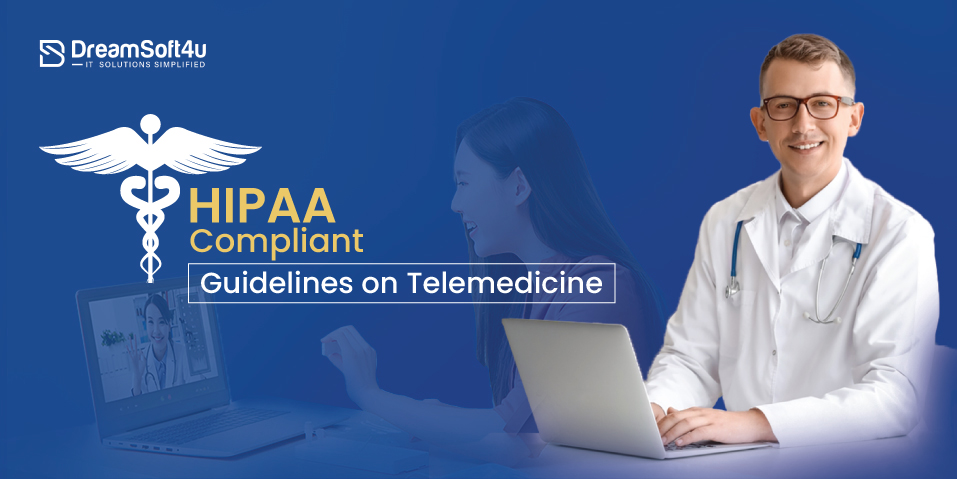The HIPAA guidelines on telemedicine apply to any medical professional or health organization that provides remote services to patients in their homes or in community centers. The HIPAA Compliance Services assumes that ePHI can be communicated at distance if the communication is between physician and patient, as many people mistakenly believe. If medical professionals or healthcare organizations wish to adhere to the HIPAA guidelines for telemedicine, they must also ensure that the communication channel used to communicate ePHI over the internet is HIPAA compliant. The HIPAA Security Rule contains this element and it stipulates:
- Access to ePHI should only be granted to authorized users.
- To protect the integrity and confidentiality of ePHI, a system of secure communications should be established.
- To prevent malicious or accidental breaches, a system of monitoring communications containing ePHI needs to be in place.
This bullet point is acceptable provided that physicians use reasonable and appropriate safeguards to protect ePHI from being divulged to unauthorised parties. The second bullet point states that ePHI should not be sent via unsecure communication channels such as email, Skype, or SMS.
According to HIPAA guidelines, any system for communicating ePHI over the internet must have mechanisms that allow remote monitoring and remote deletion of communications. If the system isn’t being used for a certain time, it should have an automatic log-off capability. The third and fourth bullet points also refer to ePHI stored – an issue that we will address in section 2.
Table of Contents
ToggleWHAT is HIPAA?
HIPAA is the acronym for the Health Insurance Portability and Accountability Act which Congress passed in 1996. HIPAA-compliant software does the following:
- Provides the ability for millions of American workers and their families to transfer and continue health insurance coverage once they change or lose their jobs
- Decreases fraud and violence of health-care
- Mandates industry-wide health care information standards regarding electronic billing and other processes;
- Needs the protection and confidential handling of protected health information
HIPAA Privacy and Security Rules
After HIPAA officially became law, the United States Department of Health and Human Services began working on the Act’s Privacy and Security Rules. The Privacy Rules came into force on 14 April 2003. These regulations specifically considered that Protected Health Information (PIH) is any information in the hands of a covered agency relating to the provision of medical treatment, health status or payment that may be connected to a particular individual.
Instructions were also provided on how to divide this information, and that the individual’s permission must be obtained before their PHI is used for research, marketing, or fundraising. In addition, patients were given the right to hide their health-related information from insurance companies if their care is privately funded.
HIPAA’s Security Rules became effective two years later on April 21, 2005. These governed the use of electronically stored PHI (ePHI), and created three security layers: technical, physical, and administrative. Under HIPAA, adherence to those rules is required. They each have the intended purpose:
Technical: To safeguard media containing PHI when electronically transmitted across open networks
Physical: To restrict access to information storage areas and prevent unauthorized access
Administrative: To put procedures and policies in place to delineate how an entity must comply with HIPAA.
Why Telemedicine Apps Must Be HIPAA Compliant?
There are many major reasons why telemedicine apps must be HIPAA compliant:
1. Keeping Patient Data Secure
Healthcare businesses can protect their patients’ sensitive data from any data breaches and unauthorized access. HIPAA Compliance will keep the data encrypted during the data transmission, storage, and access.
2. Building Trust and Credibility
HIPAA compliant shows a trust and commitment among users that their sensitive data is protected. And that builds the platform credibility and trust more to increase adoption rate.
3. Mitigating Legal and Financial Risks
If a platform is non compliant with HIPAA, then it can lead to several financial risks and legal consequences. To mitigate these risks, it is better to have a HIPAA-compliant telehealth platfrom.
4. Strengthening Telemedicine Ecosystem
Compliance also strengthens the telemedicine ecosystem. By encouraging other telemedicine apps to follow HIPAA compliance and make the healthcare ecosystem more secure.
5. Regulatory Compliance
One of the biggest reasons for following HIPAA regulations is because it is legally essential to follow them. And every healthcare app must comply with the law to minimize the regulatory risk.
Telehealth That is HIPAA Compliant
Although there are many options available for doctors who wish to offer a HIPAA compliance platfrom to patients, these can be expensive and complicated. Microsoft offers a Business Associate Agreement to physicians who want to use HIPAA-compliant Skype for Business. To take advantage of this opportunity, every patient must have an Office365 account that is linked to the cloud-based Skype for Business.
Patients may be discouraged from using a HIPAA-compliant telehealth service because of the high monthly cost (up to $35.00 per person per month). There are cheaper options, but they tend to not be as accurate for diagnosing patients’ problems. Patients may also have other applications running that could eat up bandwidth, making the service inaccessible.
Ensure Your System Is HIPAA-Compliant
Before setting up a telehealth practice, make sure that HIPAA enforcement is known to the technical experts you are recruiting. Ask to see their methods of access controls and data encryption. Additionally evaluate the system’s backup and disaster plans. These should include offsite backup options in the event of catastrophic breaches or system crashes. Finally, make sure that every member of staff in your technology provider is familiar with HIPAA compliance for software development, and willing to participate in regular internal audits. Ask for copies of the disaster recovery plan from your vendor, as well as credentials and instructions for access control.
Some Common HIPAA Violations
HIPAA is a federal law that regulates healthcare professionals to protect patients’ sensitive data. However, healthcare businesses still face some violations. Here are some common violations that occur:
1. Lost or Stolen Electronic Devices: If an electronic device stores some sensitive information about patients and it is lost or stolen then it comes in the violation of HIPAA.
2. Improper Disposal of PHI: If patients sensitive information is thrown away. Without properly destroying it then it can be easily accessed by any unauthorized person. It leads to improper disposal and counts as a violation of HIPAA.
3. Electronic Health Record (EHR) Breach: If there is unauthorized access to patients digital health records, then there comes an EHR break. And it is a serious violation.
4. Unauthorized Access to PHI: If a person is accessing patients information without having permission or uses then it leads to violation of HIPAA.
5. Failure to Conduct a Risk Analysis: When healthcare organizations need to do regular checks for patients’ information but miss it. It counts as vulnerable and leads to data breaches.
6. Lack of Encryption: As per the standard regulation, patients information must be shared in standard data format digitally. And it needs to be encrypted to prevent unauthorized access. However, if it lacks encryption then it also counts as a violation of HIPAA.
7. Inadequate Training of Employees: In a healthcare organization, every healthcare worker must be trained properly to protect the patients information from unauthorized access. Inadequate training of employees can also lead to violation.
8. Failure to Obtain Patient Consent: When an important and sensitive patient’s details are shared with others, then healthcare providers need to ask for the patient’s permission. If they share the information without the patient’s concern, then it leads to a violation of HIPAA.
Some Concluding Thoughts on the HIPAA Telemedicine Guidelines
Initially, secure messaging technologies were designed to promote HIPAA-compliant messaging, but many of the features of secure messaging have resulted in benefits that have improved healthcare professionals’ workflows, lowered medical facility costs and increased the standard of healthcare received by patients.
Most healthcare organizations have been pleasantly surprised at the simplicity with which to comply with the HIPAA telemedicine guidelines can be, and even more pleasantly surprised at the expense with no need to invest in costly hardware or complex software, or finish the organization´s IT resources.
The HIPAA telemedicine guidelines make it very clear what steps need to be placed in place to ensure the safety of ePHI. With major advantages to introducing a secure messaging solution, it is just a question of time before all covered entities providing a telemedicine services are communicating with the secure messaging ePHI at distance.
Why Consider DreamSoft4u to Build Telemedicine Software?
DreamSoft4u is one of the leading healthcare app development companies, which is known for their custom solutions for healthcare business and excellent support. If you want to build a feature rich healthcare app then we have a team of professionals who will understand your requirements and build a feature rich and HIPAA Compliant telemedicine software for your business to drive desired results. Connect for a free consultation today!
Looking for Custom HIPAA Compliant Telehealth Software for Your Business?
We have a team of experts to deliver cost effective solutions.
Conclusion
Following the HIPAA Complaint guidelines is not an option. It is a mandatory guideline that every healthcare business needs to follow to protect the sensitive information of their patients from unauthorized access. We hope this article helps you know everything about HIPAA compliant guidelines, their importance to follow, violations occurring, and much more. So, if you are planning to build telemedicine software, then make sure to follow HIPAA complaint guidelines to prevent unauthorized access and smooth operations.
FAQs
Q1. What is the HIPAA compliant protocol?
HIPAA Compliant is a protocol which contains a set of privacy and security rules and regulations especially for the healthcare organizations and professionals to protect and maintain patients’ sensitive information from unauthorized access.
Q2. How to be HIPAA compliant?
In order to be HIPAA compliant, a healthcare organization needs to follow some security and privacy laws such as data encryption, authorized access only, proper training and education to ensure compliance, and annual security risk assessment.
Q3. What are some of the challenges involved in implementing HIPAA?
HIPAA compliance is a challenging and complex task that requires strict rules and high costs while implementing healthcare app development.
Q4. How much does it cost to build a HIPAA compliant telemedicine app?
To build a HIPAA compliance telemedicine app then, it ranges between ₹150,000 to ₹650,000. However, the cost can vary based on different factors such as features, design complexity, timeline, add in functions, lotions, and much more.





















